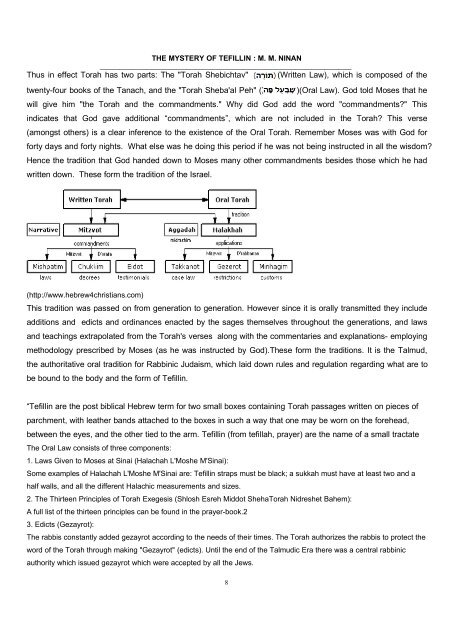Create successful ePaper yourself
Turn your PDF publications into a flip-book with our unique Google optimized e-Paper software.
THE MYSTERY OF TEFILLIN : M. M. NINAN<br />
____________________________________________________________________________<br />
Thus in effect Torah has two parts: <strong>The</strong> "Torah Shebichtav" (Written Law), which is composed <strong>of</strong> the<br />
twenty-four books <strong>of</strong> the Tanach, and the "Torah Sheba'al Peh" (<br />
)(Oral Law). God told Moses that he<br />
will give him "the Torah and the commandments." Why did God add the word "commandments?" This<br />
indicates that God gave additional “commandments”, which are not included in the Torah? This verse<br />
(amongst others) is a clear inference to the existence <strong>of</strong> the Oral Torah. Remember Moses was with God for<br />
forty days and forty nights. What else was he doing this period if he was not being instructed in all the wisdom?<br />
Hence the tradition that God handed down to Moses many other commandments besides those which he had<br />
written down. <strong>The</strong>se form the tradition <strong>of</strong> the Israel.<br />
(http://www.hebrew4christians.com)<br />
This tradition was passed on from generation to generation. However since it is orally transmitted they include<br />
additions and edicts and ordinances enacted by the sages themselves throughout the generations, and laws<br />
and teachings extrapolated from the Torah's verses along with the commentaries and explanations- employing<br />
methodology prescribed by Moses (as he was instructed by God).<strong>The</strong>se form the traditions. It is the Talmud,<br />
the authoritative oral tradition for Rabbinic Judaism, which laid down rules and regulation regarding what are to<br />
be bound to the body and the form <strong>of</strong> Tefillin.<br />
“Tefillin are the post biblical Hebrew term for two small boxes containing Torah passages written on pieces <strong>of</strong><br />
parchment, with leather bands attached to the boxes in such a way that one may be worn on the forehead,<br />
between the eyes, and the other tied to the arm. Tefillin (from tefillah, prayer) are the name <strong>of</strong> a small tractate<br />
<strong>The</strong> Oral Law consists <strong>of</strong> three components:<br />
1. Laws Given to Moses at Sinai (Halachah L'Moshe M'Sinai):<br />
Some examples <strong>of</strong> Halachah L'Moshe M'Sinai are: Tefillin straps must be black; a sukkah must have at least two and a<br />
half walls, and all the different Halachic measurements and sizes.<br />
2. <strong>The</strong> Thirteen Principles <strong>of</strong> Torah Exegesis (Shlosh Esreh Middot ShehaTorah Nidreshet Bahem):<br />
A full list <strong>of</strong> the thirteen principles can be found in the prayer-book.2<br />
3. Edicts (Gezayrot):<br />
<strong>The</strong> rabbis constantly added gezayrot according to the needs <strong>of</strong> their times. <strong>The</strong> Torah authorizes the rabbis to protect the<br />
word <strong>of</strong> the Torah through making "Gezayrot" (edicts). Until the end <strong>of</strong> the Talmudic Era there was a central rabbinic<br />
authority which issued gezayrot which were accepted by all the Jews.<br />
8


















